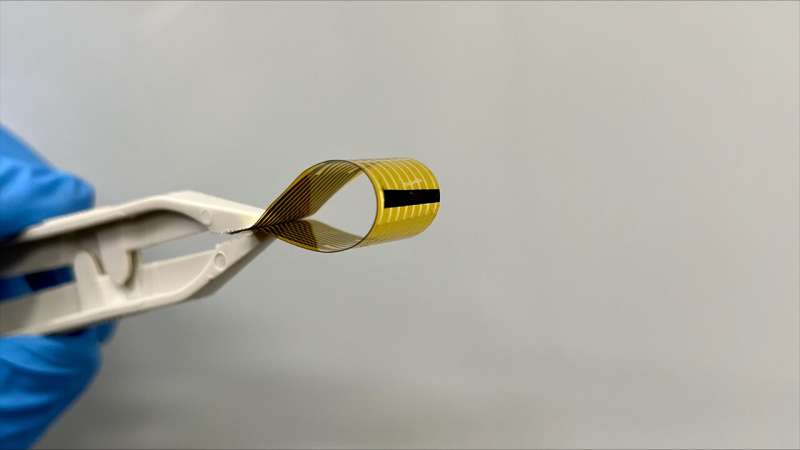This article has been reviewed according to Science X's editorial process and policies. Editors have highlighted the following attributes while ensuring the content's credibility:
fact-checked
peer-reviewed publication
proofread
Advance in flexible photodetector could improve monitoring of greenhouse gases

There will soon be a new tool to fight global warming with the development of lightweight flexible light sensors that can simultaneously image across a wide spectral range, from the visible to the infrared, with minimal optical components. This makes it perfect for drones and satellites deployed to monitor greenhouse gas emissions.
Conventional cameras use flat sensor arrays and complex optics. These have bulk and weight, complex fabrication processes, and limited spectral ranges. Consequently, monitoring greenhouse emissions using drones and satellites is expensive, given production and operating costs, and the sensors may not detect all gases.
In research published today in Advanced Functional Materials, researchers at TMOS outline their work on a new flexible photodetector that can detect visible to long-wave infrared radiation, covering the full spectrum of greenhouse gases without the need for complex optical components. Its production is simple and scalable, reducing costs significantly. It operates at room temperature, removing any need for cryogenic cooling, which is not the case for typical mid-wave infrared cameras.
Lead author, Sivacarendran Balendhran says, "Conventional sensors that have flat arrays require multiple optical components to correct the distortion that occurs around the edges of an image taken with a flat sensor. This increases the size and the weight of the sensor. Flexible photodetectors will enable curved focal plane arrays mimicking the retina of the human eye, allowing you to capture images with a simple lens.
"In addition, current technology requires different types of cameras to cover such a broad spectral range and requires cryogenic cooling in some spectral bands. They usually work with either the infrared spectrum or the visible one. Our detector allows imaging across both, at room temperature."
In addition to an ultra-broad spectral range and a small footprint, these new flexible photodetectors are more simple and cost effective to make than most traditional technologies. Commercial infrared detectors comprise multiple elements—a sensor and the electronic circuits that convert the infrared signals. The sensors use vanadium oxide (VOx) however, it's a complex material to grow, requiring temperatures above 450 degrees.
The electronic circuits that work in tandem with the sensors are created using large-scale CMOS fabrication, which requires temperatures to be below 200 degrees. In most cases, to satisfy the manufacturing requirements of both parts, the infrared sensor is suspended from a bridge structure and placed within a vacuum pack. This isolation of the infrared sensor from the circuitry is effective but makes the detector inflexible.
The research team developed a new method for creating the sensors by using VOx nanospheres grown as a powder by researchers at the University of Melbourne and then mixing it with alcohol. This suspension can be dropped onto flexible circuitry at low temperatures, negating the need for a bridge, vacuum pack or complex optics.
Balendhran says, "We've demonstrated the capabilities of our detectors in a curved focal line array. The next step in our research is to manufacture a curved focal plane array."
Chief Investigator Kenneth Crozier says, "Infrared detectors are an essential component in various fields such as telecommunications, imaging, sensing, and surveillance. The integration of IR detectors into flexible platforms offers numerous benefits across various industries, including wearable sensors in the med-tech field, high-performance cameras with increased field of view and sensitivity in defense and security, and lightweight drone-operated sensors for Australia's agritech space. The simple and scalable material synthesis and device fabrication processes make our approach a game-changer for these applications."
More information: Sivacarendran Balendhran et al, Flexible Vanadium Dioxide Photodetectors for Visible to Longwave Infrared Detection at Room Temperature, Advanced Functional Materials (2023). DOI: 10.1002/adfm.202301790





















